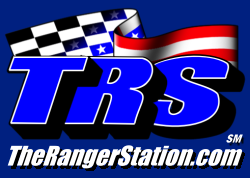Camouflage marking of vehicles is a very popular subject. Many people who have privately owned military vehicles choose to paint them with a camo pattern, even if it is not authentic for the time period of the vehicle. For example, the popular Woodland Camo pattern was not in use until 1975 but its not hard to find M-37 trucks from the 1950s and 1960s painted with that camouflage pattern.

General Information about Camouflage
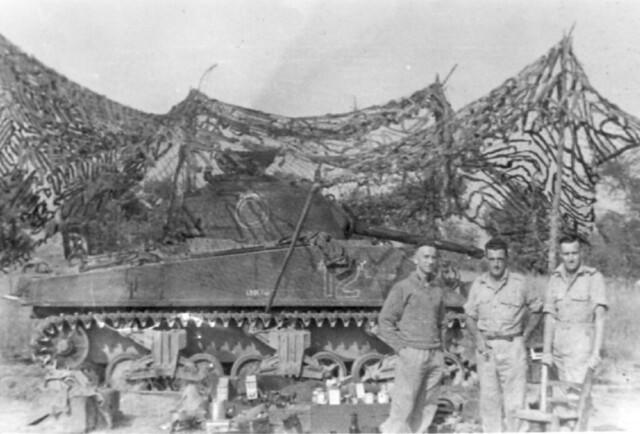
Camouflage is the art of making military objects harder to see. In the past this was done by simple field expedients, such as the use of brush or earth berms to conceal a location such as a gun emplacement, encampment, or supply dump. After aircraft came into use, it was also necessary to change the appearance as seen by overhead observers, a need that now must consider how a site will took from a satellite. In the modern age there are also requirements to defeat the use of sophisticated sensors that look for infrared signatures or probe for other wavelengths that may reveal military equipment, personnel, or activity.
Camouflage netting augmented with local materials has long been used to conceal static positions, as in the photo, left, showing a howitzer position of the 2ID near Brest, 1944. In addition to camouflage of static positions with nets and brush, camouflage doctrine included efforts to conceal the tracks when vehicles were moved.
U.S. Military Vehicles Before 1975
During World War II and after, until camouflage came into general use in 1975, U.S. vehicles were typically painted olive drab with blue drab or white markings. Several different shades of olive drab were used officially while un-officially vehicles were painted in local shops with whatever was available. The color specification for olive drab went through a number of changes over the years, explained in detail on the linked page.
Vehicles were selectively camouflaged with paint in World War II, according to FM 5-20B (April 1944) “Camouflage of Vehicles” which called for patterns composed of a light color and a dark color:
Black or olive drab have proved satisfactory dark colors in several theaters of operations. The light color is selected to match a light color typical of and predominant in the terrain in which the vehicle operates. White or light gray paint is applied to the undersurfaces of vehicles to cause them to reflect light, thus lightening the dark shadows of the undercarriage. This is called countershading.
Figures 38 to 40 of FM 5-20B were color plates showing vehicles painted olive drab with black (for temperate zones and jungle), olive drab with earth red (for desert terrain), and olive drab with white (for snow and trees).
4 Color vs. 3 Color Camouflage
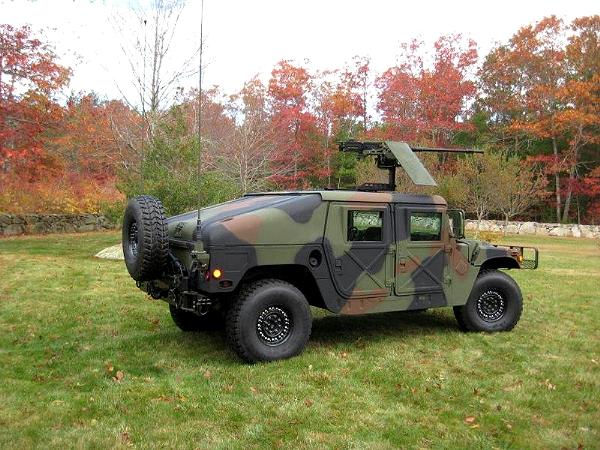
When camouflage for general use on vehicles was introduced in 1975, the patterns called for four colors. This type of pattern painting is described in TB 43-0147 “Color, Marking, and Camouflage Patterns (December 1975). The page ‘Military Vehicle Camouflage Patterns‘ contains patterns for vehicles in military inventory at that time. The four-color patterns are sometimes called MERDC patterns, named for the Mobility Equipment Research and Design Command that designed them.
During the 1980s the NATO countries, including the United States, agreed on a new camouflage scheme for vehicles, one with three colors (HMMWV photo, above). The camouflage manuals were updated in 1988 and 1990 to reflect the new standard:
- TB 43-0209 Color, Marking, and Camouflage Painting of Military Vehicles, Construction Equipment, and Materials Handling Equipment. 30 Oct 1990. Change 1, May 1991
- TM 43-0139 Painting Instructions for Army Materiel (Oct 1988 with Changes 1-3)
The three-color patterns are sometimes called NATO camo or CARC camo, the latter for the paint used, although CARC was also used for four color painting. NATO itself uses the term SCAPP: Standard Camouflage Pattern Painting, described in a North Atlantic Council document, Brussels, Feb 1993.
Camouflage Pattern Painting
This circular describes an improved method of camouflaging military equipment and how to apply it to existing equipment. This improved method is simple, and field tests have proved that it works well in confusing the enemy observer and enhancing battlefield survivability. It consists of painting newly developed patterns on the equipment, using only four colors. The patterns (different for each model of vehicle or item of equipment) have been carefully worked out by a team of camouflage experts and scientists. Unlike older camouflage patterns, this is a general all-purpose pattern. By changing only one of the four colors, or at most, two, the same basic pattern can be made to work equally well in different seasons of the year or on different types of terrain.
The theory behind this new pattern-painting design is to provide a system that can be adapted to various geographical and seasonal changes by the changing of one or, at most, two colors. For instance, the forest green can be changed to sand for desert operations, or the field drab changed to dark green and the sand to field drab for temperate climate terrain in summer. By using the appropriate color from the standard camouflage color chart (below) in conjunction with the pattern-painting design, a good color combination for almost every terrain can be obtained.
These new designs also lend themselves to touchup painting with better results than are now obtainable from touchup of the current OD vehicles. Slight mismatches in color will not be as noticeable as they are on a solid-colored vehicle except from very close inspection. Likewise, minor abrasions and scaling of surfaces will be equally inconspicuous.
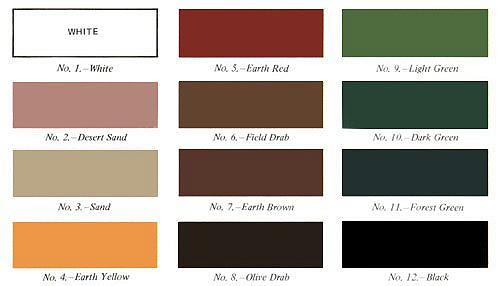
Camouflage Patterns and Colors
The camouflage pattern consists of wavy, irregular patches of color applied to the vehicle. The colors used for the patterns have been selected from the standard camouflage colors as shown in the chart above. The standard colors are:
| No. | Abbreviation | Color |
| 1 | W | White |
| 2 | DS | Desert Sand |
| 3 | S | Sand |
| 4 | EY | Earth Yellow |
| 5 | ER | Earth Red |
| 6 | FD | Field Drab |
| No. | Abbreviation | Color |
| 7 | EB | Earth Brown |
| 8 | OD | Olive Drab |
| 9 | LG | Light Green |
| 10 | DG | Dark Green |
| 11 | FG | Forest Green |
| 12 | BL | Black |
The patterns use only four of these colors, for any geographic or climatic conditions. The only exception is winter arctic, which is solid white. When changing from one geographic or climatic condition to another, the shape of the pattern itself does not change; only one or two of the colors that make up the pattern change. The next table shows the combinations of colors to be used for various seasons and climatic regions. The first and second colors each cover about 45% of the vehicle; the third color covers 5% of the vehicle; and the fourth color, normally black, covers the remaining 5%. The color numbers 1, 2, and 3 identify the first three colors, and are used in the pattern designs to show what color goes where on the vehicle.
| Condition | Color Distribution | |||
| 45% | 45% | 5% | 5% | |
| Color Number | ||||
| 1 | 2 | 3 | 4 | |
| Winter US & Europe – verdant (1) | FG | FD | S (3) | BL |
| Snow – temperate w/trees & shrubs (2) | FG | W | S (3) | BL |
| Snow – temperate w/open terrain | W | FD | S (3) | BL |
| Summer US & Europe – verdant (1) | FG | LG | S (3) | BL |
| Tropics – verdant | FG | DG | LG (3) | BL |
| Gray desert | S | FD | EY (3) | BL |
| Red desert | ER | EY | S (3) | BL |
| Winter Arctic | W | W | W | W |
| Notes:
1. Verdant means generally green — in summer due to trees, shrubs, and grass; in winter due to evergreens. 2. This color combination is for use only in areas that occasionally have snow which does not completely cover the terrain, thus leaving trees or patches of soil bare. 3. This 5% color should be the camouflage color that matches most closely the color of the soil in the local area. A typical color for such use is sand, but earth red, earth yellow, or one of the others may be closer to the predominant soil color and, in that case, should be used. |
||||
The color patterns in the above table were designed for world-wide application and cover a wide range of terrain conditions. It is possible that any given color combination may not be an exact match for some specific local condition. In such a case, the 12 colors available in camouflage paints give the local commander wide latitude to modify the color combination and develop one that more closely matches the local terrain and operating conditions. Note: Individual colors must not be mixed with one another as this will destroy the camouflage characteristics of the paint.
New items of tactical equipment will be painted lusterless forest green at the factory. Since the base paint of forest green is usually one of the large 45% color areas, troops will have to pattern paint only three colors. The actual paint to be added will then be one large 45% area and the two small 5% areas.
Note: Since the areas and climates in which newly manufactured vehicles will operate cannot be predicted, it is not practical to pattern paint new vehicles at the factory.
To see camouflage paint patterns, visit ‘Military Vehicle Camouflage Patterns‘.
OD (Olive Drab) Paint for Military Vehicles
U.S. Army military vehicles were painted olive drab from prior to World War II until the introduction of camouflage patterns in 1975. The history and evolution of the olive drab color, its gloss, and the authorized markings are fascinating, but the main motivation is usually an unpainted jeep in the garage. What color the jeep (or truck, tank, DUKW etc.) should be depends on a) the time of manufacture, and b) the unit and time to be represented by your restoration. You have to decide exactly what time and place your vehicle represents, then you can choose the paint appropriate to that choice.
Evolution of the Olive Drab Paint Specification
The olive drab paint used on military vehicles at the factory, on replacement parts, and in the field depended on a number of factors. Experts on the history of military vehicle paint procurement and practices (Jim Gilmore, Fred Coldwell, Steve Zaloga, David Doyle and others) have spent countless hours in the National Archives and with the production records of government contractors such as Ford and Willys trying to ascertain the exact technical specs on olive drab paint used at various times and places. They have compiled a mass of information and have shared it in books and articles as well as personal communications or open forums.
Despite this awe inspiring research, there are still many questions that are hard or impossible to answer. After the original 1940 contract with Pittsburgh Plate Glass (PPG), Lustreless Olive Drab Enamel was procured from multiple vendors. Despite rigid standards, variations crept in. As replacement parts were painted at times and places distant from the original vehicle production, variations increased. As units in the field painted and repainted vehicles for maintenance, to comply with orders as they moved from place to place, and to keep up with changing regulations, variations increased. With all the variation, it would be hard to say exactly what paint would match a given vehicle without opening a can of paint and seeing how it matched or didn’t.
This table is an outline of the basics of olive drab paint standards and specifications used by the U.S. Army starting with 1940. Prior to 1940, vehicles were painted with a glossy olive drab enamel (“long oil”). Vehicles such as staff cars, metropolitan ambulances, or other non-tactical vehicles outside combat areas continued to use gloss paint after Lustreless Olive Drab became the standard. The Army Air Corps and other services had their own, different, paint standards.
| Date | Shade | Authority/Reference |
|---|---|---|
| 1940 | Lustreless Olive Drab Enamel
QM Color No. 22 Corps of Engineers Color No. 9 |
QM Specification ES-474 (or ES-474-B):
painting standards QM Specification 3-1 Color Card Supplement Corps of Engineers 1942 Color Card Pittsburgh Plate Glass Contract No. 398-QM-8694 No. 1135) (and other manufacturers following) Fed. Stock No. 51-E-4171-15 (one gallon) or 51-E-4172 (five gallons) |
| 1943 | Lustreless Olive Drab | Specification 3-1F Color Card Supplement
(Revision 1) Corps of Engineers 1942 Color Card |
| 1943 | A/N 319 Olive Drab
Lustreless, very similar to QM Color No. 22 but different chemical composition. Not commonly used for vehicles. |
Army Resources and Production Division
Joint Army-Navy color specification A/N 319 |
| 1944 | A/N 319 Olive Drab
Improved moisture seal, slight gloss |
See Doyle, Appendix 2 |
| 1945 | Olive Drab, Semigloss | Army Regulation 850-15 1 Aug 1945
Specification 3-181, Amendment 3, Type V Fed. Stock No. 52-E-7574 (one gallon) |
| 1950 | OD 3412 (flat) and OD 2430 (semigloss)
Color equivalent to Lustreless Olive Drab |
TT-C-595 Colors for Ready Mixed Paint |
| 1956 | OD 34087 (equivalent to OD 3412)
OD 24087 (equivalent to OD 2430) OD 14087 (gloss) 34087 is not the same color as 14087/24087 an error that persisted until FS595A Change 7 in 1984 |
Federal Standard FS595 |
| 1960 | OD X34087
OD X24087 OD X14087 Lighter and yellower than previous paints with same number. X indicates interim. |
Federal Standard FS595 Addendum 2
Issued by: US Army Signal Equipment Support Agency |
| 1968 | OD 34087 (same as X34087)
OD 24087 (same as X24087) OD 14087 (same as X14087) Colors not the same as FS595 same numbers |
Federal Standard FS595A
as revised by Change 3, 28 April 72 |
| 1984 | OD 34087/24087/14087 deleted
OD 34084/24084/14084 same color as 14087 – from FS595 OD 34088/24088/14088 same color as 34087 – from FS595 OD 33070 (equivalent to A/N 319 Lustreless OD OD 33070 is similar color in camouflage section |
Federal Standard FS595A Change 7 |
| 1989 | Only significant change was 24087 which has
been reassigned to an unrelated color |
Federal Standard FS595B |
Note: The spelling of “lustreless” — this is the original spelling on the PPG paint chart from 1940, not “lusterless.”
Reality of Olive Drab Military Vehicle Paint

If your objective is to reproduce the olive drab paint for a WW II vehicle, then the above information leads you to paint identified as Lustreless Olive Drab Enamel, aka OD#22 or OD#9. Virtually all WW II vehicles were painted with Lustreless Olive Drab Enamel. You can also use paint identified as A/N 319 which is quite similar in appearance. After WW II, the standard for most vehicles moved to semi-gloss and OD 2430 was used until 1956 after which the very similar OD 24087 remained in use until camo was adopted in 1975.
The problem is that the modern paint can may have these numbers on it, but how do you know the paint is the right color, shade and gloss like your vehicle had in the 1940s or 1950s? In fact, you don’t know.
Even during WW II, paint from different manufacturers or different batches from the same manufacturer did not always match. Despite the best efforts of inspectors at the paint manufacturer and at the vehicle factories, there are eyewitness accounts and photos that document multiple color shades on identical vehicles from the same factory. They are similar, but when seen side by side they are not the same. Therefore, it should not be surprising that sixty years later there is less than complete agreement on what these colors should be.
Some of the modern paint manufacturers have made sincere efforts to research and experiment with the paints to get as close as possible to “WW II olive drab.” Untouched panels from original vehicles are available and occasionally an unopened can of paint from WW II will show up for comparison. Of course, the passage of time changes chemicals like paint and any paint exposed to light will fade. Different paints, even if originally the same color, will fade to different colors. So any of these matching techniques are ultimately subjective.
Digital Camouflage
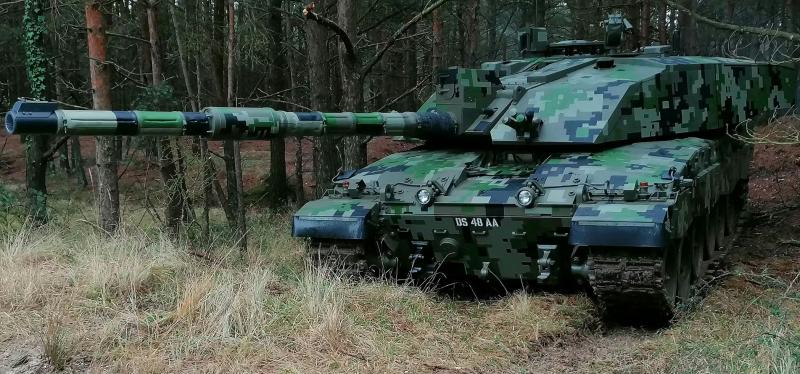
(British tank with digital camouflage)
The U.S. military began experimenting with pixelated or “digital” camouflage in the early 2000s after the success of digital uniform patterns such as MARPAT and CADPAT. Engineers and vehicle programs — notably Stryker and a handful of Humvee and LAV demonstration projects — tested pixellated paint schemes and mobile camo systems to see if computer-generated patterns could break up large vehicle outlines at multiple engagement distances and in different light bands (including near-IR).
In practice the service wide shift never fully replaced theater-color single paints (desert tan, olive drab) because of cost, fleet logistics, and mixed concealment results: repainting thousands of vehicles is expensive, and tests showed digital vehicle patterns didn’t always offer a decisive advantage over simpler macro-patterns or single colors at typical vehicle engagement ranges. Today you’ll still see digital schemes used for experiments, specialty units, and display vehicles, but most operational trucks remain painted in theater-appropriate solid colors for speed, maintenance, and cost reasons.
Photo reference: Saab — Mobile Camouflage System on a Stryker (image and writeup showing digital/mobile camo testing).
About The Author
Jim Oaks is the founder of TheRangerStation.com, the longest-running Ford Ranger resource online since 1999. With over 25 years of hands-on experience building and modifying Ford Rangers — including magazine-featured builds like Project Transformer — Jim has become one of the most trusted authorities in the Ford Ranger off-road and enthusiast space. In 2019, he was loaned a Ranger FX4 by Ford Motor Company to test and document across the TransAmerica Trail. Jim continues to inspire and guide Ranger owners around the world.
